Northeastern Wildflowers: A Comprehensive Exploration
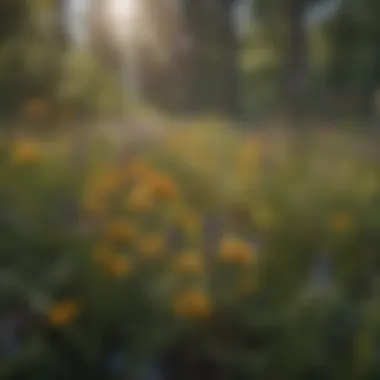
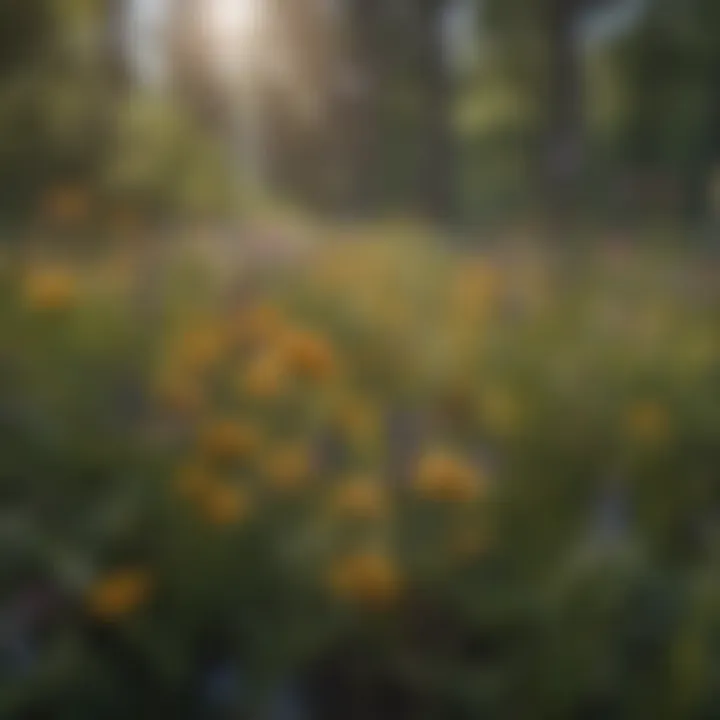
Intro
The northeastern United States boasts a rich diversity of wildflowers that play crucial roles in local ecosystems. This article aims to provide a thorough exploration of these unique plants, focusing on their ecological functions, cultivation, and conservation measures necessary for their survival. Understanding wildflowers in their natural habitat helps us appreciate their beauty and significance.
Understanding Woodland Ecosystems
The interconnectedness of species in woodland ecosystems highlights the significance of biodiversity. Wildflowers serve as essential food sources for pollinators like bees and butterflies. They also provide habitat and shelter for insects, birds, and small mammals. The variety of species present enriches the forest environment, maintaining a balanced ecological scene.
Importance of Biodiversity in Forests
Biodiverse forests contribute to the resilience of ecosystems against climate change and disease. A varied plant community supports a wider array of animal species, creating stable habitats. Furthermore, diverse plant life can improve soil quality and water retention, which supports everything from fungi to larger fauna. Many endemic species of wildflowers, such as the Trillium grandiflorum, demonstrate the intricate relationships formed in these ecosystems.
Role of Forests in Climate Regulation
Forests act as carbon sinks, storing CO2 and thus helping regulate the climate. Their complex structure allows them to capture and store water, impacting local weather patterns. With the persistent threats of climate change, understanding how wildflowers contribute to carbon cycling is crucial for both conservationists and policymakers.
Conservation Efforts
The threats faced by wildflowers, such as habitat loss and invasive species, necessitate immediate action. Conservation initiatives aim to restore native plant populations and educate the public about the importance of preserving these species. Many organizations work collaboratively to enhance awareness and implement measures that protect these vital plants.
Cultivation Practices
Growing native wildflowers in gardens promotes biodiversity and supports local wildlife. It is essential to understand the native conditions of these plants to ensure their successful cultivation. Techniques like using local seed sources and providing suitable soil and light conditions can aid in cultivating healthy specimens.
Threats to Existence
The prevalence of exotic species poses a significant risk to native wildflower populations. Invasive plants can outcompete local flora, altering ecosystems and diminishing biodiversity. Climate change also threatens the delicate balance of these environments, impacting both the distribution and vitality of such plants.
End
Foreword to Northeastern Wildflowers
The presence of wildflowers in the northeastern regions of North America is more than just a visual pleasure; it encapsulates an intricate part of the ecosystem. This introduction aims to shed light on the significance of these flowers, recognizing their ecological roles, cultural connections, and socio-economic implications.
Wildflowers serve as vital components in their natural habitats. They contribute to biodiversity, support pollinators such as bees and butterflies, and stabilize soil through root systems. Understanding these flowers aids in grasping the health of local ecosystems. Furthermore, they have educational value, offering insights into ecological balance and the environment's functioning.
This article also considers the aesthetic value of wildflowers. Their vibrant colors and forms inspire creativity, attracting nature enthusiasts, artists, and educators alike. The seasonal changes bring unique wildflower displays, enhancing the allure of natural landscapes and enabling a connection to the environment.
Defining Northeastern Wildflowers
Northeastern wildflowers encompass various flowering plants native to the northeastern United States and parts of Canada. These species exemplify adaptations to local climate, soil types, and ecological niches. Differentiating between wildflowers and cultivated plants is crucial. Wildflowers grow naturally without human intervention, thriving in diverse terrains, whereas cultivated varieties may not exhibit the same resilience or adaptability.
Identifying key characteristics can aid in recognizing wildflowers. Traits such as color, flower shape, leaf structure, and growth patterns provide a framework for species identification. Additionally, many of these plants have significant uses in traditional medicine, culinary applications, or as ornamental varieties.
Geographical Context
The geographical expanse of the northeastern region is a blend of various habitats, from coastal plains and mountains to wetlands and forests. Each of these environments hosts unique wildflower populations adapted to their surroundings. Influences such as temperature, rainfall, and elevation determine the floral communities of eastern forests.
Wildflowers flourish in the rich, diverse soils that result from the area's distinct geological history. Understanding the geography allows for a deeper appreciation of the relationships that exist between plant species and their ecosystems.
In summary, the study of northeastern wildflowers serves multifaceted purposes. From ecological implications to cultural relevance, their exploration offers valuable insights and fosters an appreciation for regional biodiversity.
Ecological Roles of Wildflowers
Wildflowers in the Northeastern United States play crucial ecological roles that extend beyond mere beauty. They serve multiple functions that sustain local ecosystems, influencing everything from biodiversity to soil health. A thorough understanding of these roles is essential for conservation efforts. Preserving these flowers means safeguarding the intricate web of life that relies on them.
Pollinator Support
One of the most significant contributions of wildflowers is their role in supporting pollinators. Many species of pollinators, such as bees, butterflies, and hummingbirds, depend on these flowers for nectar and pollen. The diversity of wildflower species offers various resources that cater to different pollinators throughout the growing season. Research has shown that a richer diversity of wildflowers can increase pollinator populations. This biodiversity contributes to the stability of ecosystems.
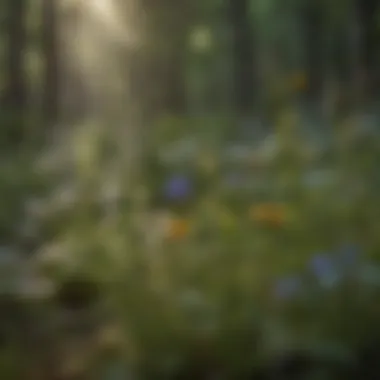
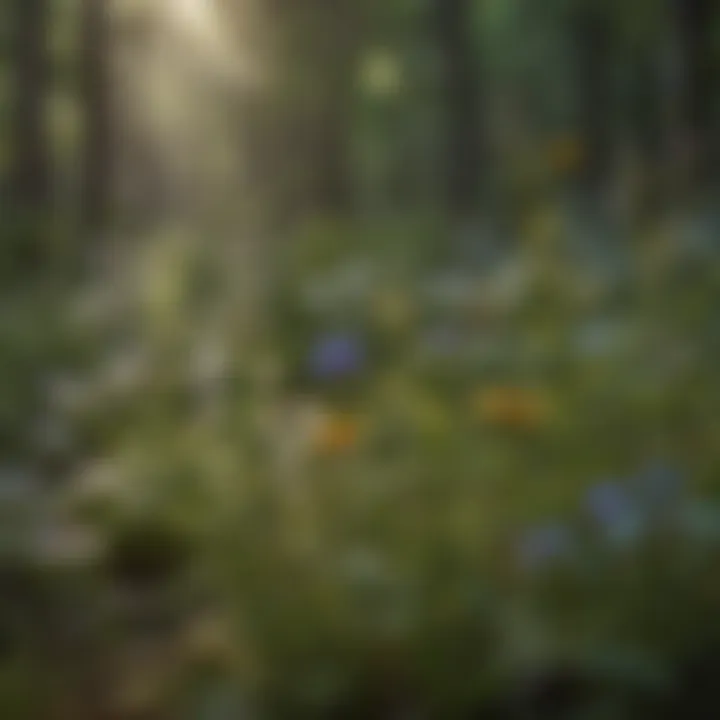
"The relationship between wildflowers and pollinators exemplifies a vital ecological connection. Without one, the other cannot thrive."
Promoting native wildflower planting can enhance local populations of bees and other pollinators. In addition, many agricultural crops also rely on these pollinators for effective fruit and seed production. Thus, wildflowers contribute to both ecological balance and agricultural productivity.
Soil Health Improvement
Wildflowers also play a vital role in improving soil health. Their root systems help to stabilize the soil, reduce erosion, and enhance nutrient cycling. As wildflowers grow, they contribute organic matter to the soil when their leaves drop or when they die back at the end of the growing season. This organic matter is fundamental for soil structure and fertility.
Some wildflowers, such as Clover and Alfalfa, are known for their nitrogen-fixing abilities. This process essentially converts atmospheric nitrogen into a form that plants can use, enriching the soil. When wildflowers are integral to a planting scheme, they can improve land use sustainability, which is essential in an era of environmental challenges.
Common Wildflower Species
Understanding common wildflower species is crucial in appreciating the biodiversity within northeastern ecosystems. These plants serve numerous ecological functions, including supporting pollinators and contributing to soil health. Additionally, being aware of various species helps foster an environment conducive to conservation efforts. By recognizing the importance of these wildflowers, we can better engage in practices that enhance their survival. In this section, we will explore four key wildflower species found in the northeastern United States: Butterfly Weed, Jack-in-the-Pulpit, Trillium, and Black-eyed Susan.
Butterfly Weed
Butterfly Weed, known scientifically as Asclepias tuberosa, is a native perennial that thrives in sunny habitats. It is recognized for its vibrant orange-yellow flowers, which bloom in clusters during the summer months. This wildflower is particularly valuable for its role as a nectar source for butterflies, including the iconic Monarch Butterfly. By cultivating Butterfly Weed, gardeners can create a more inviting atmosphere for these crucial pollinators. Furthermore, it requires well-drained soil and can tolerate drought conditions once established. Its adaptability makes it a prime candidate for both natural and decorative landscaping.
Jack-in-the-Pulpit
Jack-in-the-Pulpit, or Arisaema triphyllum, is a distinctive wildflower commonly found in wooded areas and along streams. Its unusual flower structure resembles a hooded pulpit, hence the name. This plant is fascinating not only due to its morphology but also for its ecology. Jack-in-the-Pulpit is a vital part of its ecosystem, providing shelter and sustenance to various insects and small mammals. It thrives in shaded environments with moist, rich soil, showcasing how specific plants can offer habitat diversity within their habitats. Gardeners interested in creating a woodland scene may find this species particularly suitable.
Trillium
Trillium is another noteworthy wildflower within the region, known for its three-petaled blooms and distinct whorled leaves. The most common species, Trillium grandiflorum, features striking white flowers that age to a pleasant shade of pink. These plants flourish in rich, well-drained soils and often inhabit woodlands where the canopy helps provide the necessary shade. Trillium species are significant in restoring forest understory environments, as they indicate a healthy and diverse ecosystem. Additionally, their slow growth and dependence on particular mycorrhizal fungi highlight the delicate balance that exists within forest habitats.
Black-eyed Susan
Black-eyed Susan, or Rudbeckia hirta, is an emblematic wildflower across northeastern meadows and gardens. Characterized by its yellow petals surrounding a dark purple center, this plant is both visually appealing and ecologically significant. It attracts various pollinators, including bees and butterflies, which depend on its nectar for survival. Black-eyed Susan is relatively easy to cultivate and thrives in well-drained soil and sunny conditions. Moreover, it has a capacity for self-seeding, assisting in the propagation of native flora. In landscape management, this species can serve as an effective ground cover, adding color while supporting local wildlife.
"Northeastern wildflowers such as Butterfly Weed and Black-eyed Susan are essential not only for their beauty but also for their contribution to local ecosystems."
In summary, the examination of these common wildflower species highlights their ecological importance and offers insights into cultivation practices. Recognizing their unique attributes allows individuals and communities to make informed decisions that contribute to the conservation of northeastern flora.
Adaptations of Northeastern Wildflowers
Adaptations are crucial for the survival of northeastern wildflowers. Given the region's diverse climatic conditions and ecological challenges, these plants have evolved unique traits that enhance their resilience. Understanding these adaptations is important for appreciating the role wildflowers play in their ecosystems and for their preservation efforts.
Drought Resistance Mechanisms
Drought conditions are a pressing concern for wildflowers in the northeastern United States. Many species have developed mechanisms to withstand prolonged periods without water. Some of these mechanisms include:
- Deep Root Systems: Wildflowers like the Coneflower extend their roots deep into the soil. This allows them to access water far below the surface that other plants cannot reach.
- Waxy Leaf Coating: A matte or glossy surface on leaves prevents water loss. This adaptation is seen in plants like Black-eyed Susan, which can thrive in hotter, drier conditions.
- Drought-Cycle Germination: Certain species only germinate when conditions are favorable. For instance, Wild Bergamot has a germination strategy that relies on seasonal cues, ensuring survival through drought.
These adaptations enable wildflowers to not only survive but flourish in their ecosystems, supporting local fauna and contributing to biodiversity.
Shade Tolerance Strategies
Shade tolerance is equally vital for many northeastern wildflowers, especially given the dense forests and varying canopy layers found in the region. The ability to survive in low light allows these plants to occupy ecological niches that other plants may not. Some strategies include:
- Chlorophyll Variations: Many shade-tolerant plants, such as Trillium, have higher concentrations of chlorophyll to maximize light absorption.
- Slower Growth Rates: Some wildflowers may grow more slowly in shaded environments but can still thrive. This is observed in plants like Jack-in-the-Pulpit, which have long life cycles that accommodate lower light.
- Leaf Adaptations: Larger or broader leaves help capture more sunlight in dim conditions. This adaptation is common in species found under forest canopies, improving their chances of survival.
It is essential to recognize these adaptations not only for botanical study but also for habitat preservation strategies, ensuring that these unique plants continue to thrive in their natural settings.
Cultivation of Wildflowers
Cultivation of wildflowers plays a vital role in maintaining the ecological integrity of northeastern landscapes. As urban areas expand and natural habitats diminish, cultivating these native plants becomes essential for preserving biodiversity. Wildflowers offer aesthetic value, enhance local ecosystems, and provide essential habitats for various organisms. This section explores crucial aspects of wildflower cultivation, emphasizing soil requirements, seasonal considerations, and propagation techniques.
Soil Requirements
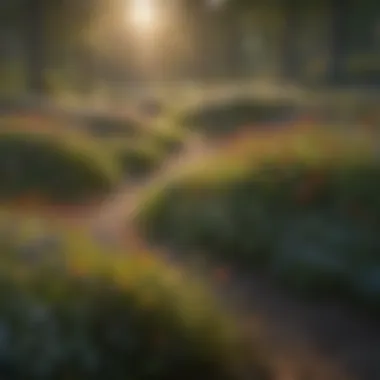

The foundation of successful wildflower cultivation lies in proper soil conditions. Northeastern wildflowers thrive in well-drained soils, as stagnant water can inhibit their growth and lead to root rot. Soil pH is equally important, with most native species preferring a range between 6.0 and 7.0.
Considerations for soil quality include:
- Organic Matter: Incorporating organic matter, such as compost, enhances soil fertility and moisture retention.
- Texture: A sandy loam texture often supports diverse wildflower species effectively.
- Nutrient Content: Conducting soil tests can guide amendments to ensure that nutrient levels are adequate without being excessively high, which can favor invasive species.
Properly amended and well-prepared soil leads to healthier plant systems, promoting a sustainable ecosystem.
Seasonal Considerations
Understanding seasonal patterns is crucial for successful wildflower cultivation. The growth cycles of wildflowers are closely tied to the climates of the northeastern regions, which experience distinct seasons.
Key seasonal considerations include:
- Spring Planting: Most wildflowers should be planted in early spring. Soil temperature is essential – typically, it should be between 60°F to 70°F for optimal germination.
- Fall Preparation: Fall is an ideal time for preparing planting beds, as it allows for natural processes, such as winter freeze-thaw cycles, to improve soil texture.
- Watering Regimens: Seasonal changes can dictate watering schedules. During hot summer months, additional irrigation may be necessary, whereas in fall, rainfall can often suffice.
Seasonal awareness helps in choosing the right moment for sowing seeds or transplanting plants.
Propagation Techniques
Successful propagation techniques are fundamental for increasing wildflower populations. Wildflowers can be propagated through seeds, cuttings, or divisions, depending on the species and available resources.
Common propagation methods include:
- Seed Stratification: Many wildflowers require a period of cold stratification to mimic natural processes, which aids in germination.
- Transplanting Seedlings: Starting seeds indoors and transplanting them later ensures higher survival rates, particularly for species sensitive to competition.
- Cuttings: Some perennial species can be propagated through stem cuttings, which can be taken in late summer.
Each technique varies in effectiveness, and understanding the specific requirements of different wildflower species can lead to better outcomes in cultivation.
Cultivating northeastern wildflowers contributes to sustainability and ecological resilience.
By focusing on these core aspects of cultivation, enthusiasts can effectively support the preservation and proliferation of native wildflowers in the northeastern United States.
Threats to Northeastern Wildflowers
The preservation of northeastern wildflowers faces numerous threats that can drastically reduce their populations and disrupt the ecosystems they inhabit. Addressing these concerns is crucial for conservationists, gardeners, and anyone invested in the ecological health of the region. Understanding the threats allows for informed actions and initiatives that can mitigate negative impacts. This section explores specific threats, including habitat loss, invasive species, and climate change, providing a clearer picture of the vulnerabilities faced by these important flora.
Habitat Loss
Habitat loss remains one of the most significant threats to wildflowers in the northeastern United States. As urban development spreads, areas that once hosted diverse wildflower populations are transformed into residential, commercial, or industrial spaces. The result is a fragmented landscape where wildflowers struggle to survive.
- Urban sprawl directly impacts natural habitats, leading to decreased wildflower populations.
- Changes in land use disturb not just the plants but also the pollinators that rely on them for food and reproduction.
- In many cases, construction and land clearing do not leave enough space for wildflowers to thrive, which affects overall biodiversity.
The loss of these habitats can be quick and irreversible, making it challenging for native species to adapt. Preservation of existing wildflower habitats through local regulations and community awareness programs can help counteract some of the damage caused by urbanization.
Invasive Species
Invasive species pose another serious threat to the wildflowers of the Northeast. Non-native plants often compete with native wildflowers for resources such as sunlight, soil nutrients, and water. Many invasive species grow at a faster rate and reproduce more effectively than their native counterparts, which can lead to a decline or even extinction of local wildflower populations.
- Some well-known invasive plants include Japanese knotweed and purple loosestrife. These species can rapidly dominate an area, choking out native flora.
- The introduction of invasive species often occurs unintentionally, through gardening practices or unregulated horticulture.
- Control measures for invasives can be labor-intensive and require ongoing management to be effective.
Addressing the threat of invasive species involves both prevention and management. Educating the public on the identification of invasive plants and effective control strategies is paramount.
Climate Change Impacts
Climate change is an overarching threat that affects northeastern wildflowers in myriad ways. Changes in temperature and precipitation patterns can disrupt the blooming cycles and habitat suitability for many wildflower species.
- Increasing temperatures may lead to a shift in species distributions, pushing some wildflowers beyond their comfort zones.
- Changes in seasonal rainfall can lead to drought conditions, which can particularly affect species that are not drought-resistant.
- Weeds and invasive plants may thrive under changing climate conditions, further complicating the survival of native species.
Incorporating climate resilience into conservation strategies for wildflowers is essential. Conservationists must not only focus on preserving existing habitats but also consider how climate change will alter those environments in the years to come.
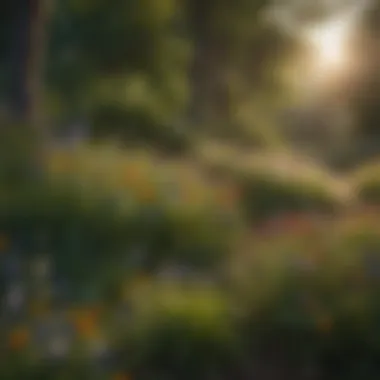

Understanding and addressing these threats is critical not only for the survival of wildflowers but also for the health of the entire ecosystem. Through concerted conservation efforts, it is possible to protect these vital species from further decline.
Conservation Efforts
Conservation efforts play a critical role in ensuring the survival of northeastern wildflowers. These initiatives are essential not only for protecting individual species but also for maintaining the broader health of ecosystems. The loss of wildflowers can have cascading effects, disrupting food webs and diminishing habitat quality for numerous other organisms. This section highlights two key aspects of conservation efforts: local initiatives and educational programs.
Local Initiatives
Local initiatives are fundamental in the conservation landscape. Many communities have recognized the need to preserve their natural flora. Several organizations work tirelessly to restore habitats and promote biodiversity. For instance, volunteers may participate in planting native wildflower species in public parks or community gardens. These actions help to create green spaces that are both beautiful and ecologically beneficial.
Another significant aspect is the establishment of protected areas. Parks like the Great Smoky Mountains National Park and various state parks provide safe havens for wildflower species. This preserves the native flora from urban development and agricultural expansion. Further, these areas often engage in active management practices, such as controlling invasive species, which can otherwise outcompete native wildflowers.
Collaboration between local government, nonprofits, and community members is vital. Such joint efforts allow for pooling of resources and expertise. It encourages more significant impact as collective action usually leads to stronger outcomes. Additionally, local schools may involve students in conservation projects, instilling a sense of stewardship towards their environment.
Educational Programs
Educational programs are imperative for raising awareness and fostering understanding regarding the importance of wildflower conservation. These programs address various audiences, from school children to adults. Schools may incorporate curriculum elements focused on plant biology and ecology. Field trips to local wildflower hotspots can deepen students’ appreciation and connection to nature.
Additionally, workshops and seminars aimed at adult populations also play a significant role. These gatherings can cover topics such as gardening with native plants, understanding ecosystems, and the ecological significance of wildflowers. Knowledge dissemination ensures that more people are aware of how they can contribute to conservation efforts.
The incorporation of technology enhances educational outreach. Online resources, webinars, and social media platforms serve as effective methods for spreading knowledge. For instance, dedicated pages on websites like Wikipedia or community discussions on Reddit allow for broader discussions about the significance of wildflowers and sharing of conservation methods.
The Cultural Significance of Wildflowers
The cultural significance of wildflowers in northeastern North America extends beyond their visual appeal. They serve as symbols of the region's biodiversity and ecological health. These flowers hold particular importance in the fabric of local traditions, lore, and community identity. They are often included in rituals and celebrations, reflecting the deep connection between people and nature. Understanding this significance helps to appreciate why these plants must be preserved and propagated.
Historical Context
Historically, wildflowers have played a crucial role in the lives of indigenous peoples in the northeastern region. They utilized local flora both for aesthetic purposes and medicinal applications. Many species were revered in cultural stories and rituals, symbolizing various teachings and connections to the natural world. Wildflowers were also used to signify seasonal changes, guiding agricultural calendars and local festivities.
European settlers adopted similar practices, often incorporating wildflowers into their gardens, using them for ornamentation, and imbuing them with meaning derived from their homelands. For example, bluebell and daisy wildflowers became symbolic in folk traditions, representing hope and renewal. This blending of cultures highlights the enduring connection between people and the landscape.
Wildflowers in Art and Literature
Wildflowers have inspired countless artists and authors throughout history. They have found their way into paintings, poetry, and prose, often symbolizing rebirth, innocence, and the ephemeral nature of life. Artists like Georgia O'Keeffe and Vincent van Gogh captured the beauty of wildflowers, revealing their allure and emotional depth in vibrant colors and sweeping brushstrokes.
Literature often reflects similar themes, with wildflowers used as metaphors for beauty and fragility. Writers such as Emily Dickinson and William Wordsworth employed floral imagery to evoke feelings of nostalgia and connection to the earth. For many, these representations reinforce the role of wildflowers in shaping personal and collective identities.
In community art projects and literary workshops, advocates emphasize using native wildflowers as a focal point to inspire environmental stewardship and local pride. The creation of wildflower gardens not only beautifies spaces but also educates people about the ecological roles these plants play in local ecosystems.
"The wildflower is like a poem; it speaks without words, conveying the subtleties of being alive."
Incorporating wildflowers into art and literature cultivates a deeper appreciation for their significance. It encourages dialogue on conservation efforts and the intricate relationships that exist within ecosystems.
The Future of Northeastern Wildflowers
The future of northeastern wildflowers holds immense importance in the context of biodiversity and ecological stability. Understanding the trends in conservation and the active roles communities can play in preserving these species is critical. As ecosystems evolve, wildflowers face multiple threats, but through targeted efforts and engagement, the trajectory can shift toward positive outcomes.
Trends in Conservation
Conservation efforts are continually adapting to the changing landscape influenced by climate and human activity. One significant trend is the focus on habitat restoration. Projects aim to rehabilitate areas where wildflowers have historically grown but have been lost due to urbanization or agriculture. By reinstating native plants, ecosystems are given a chance to recover and thrive.
Furthermore, there is growing recognition of the importance of genetic diversity. Preserving various genotypes of different wildflower species ensures resilience against diseases and environmental changes. Conservation programs are increasingly prioritizing seed bank initiatives to secure this genetic material for future use.
Another observable trend includes the involvement of technology in monitoring wildflower populations. Using data collection tools, conservationists track trends in growth and health of different species, allowing for more informed decision-making and intervention strategies. These technological advancements facilitate more effective conservation practices.
"By focusing on habitat restoration and genetic diversity, we can enhance the survival chances of local wildflower species."
Community Involvement in Preservation
Community involvement is key to the sustainability of northeastern wildflowers. Local groups and organizations often spearhead initiatives that educate the public about the significance of these plants. Workshops and outreach programs cultivate a sense of stewardship among residents.
Community gardens that incorporate native wildflowers foster awareness and allow individuals to contribute actively. These gardens create habitats for pollinators and other wildlife, enhancing local ecosystems. Residents can witness firsthand the impact of their efforts, driving enthusiasm for further involvement.
Moreover, collaborative initiatives between local authorities and conservation groups have yielded success. Engaging with stakeholders ensures that wildflower conservation becomes a collective goal. Awareness campaigns on social media platforms like Facebook and Reddit amplify these efforts, reaching broader audiences.
The future of northeastern wildflowers is contingent on these combined efforts. By harnessing the power of communities and implementing effective conservation trends, we can work towards an ecosystem that not only thrives today but also paves the way for future generations.







